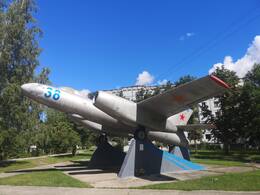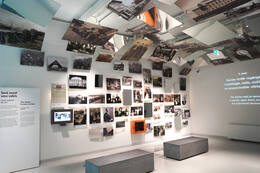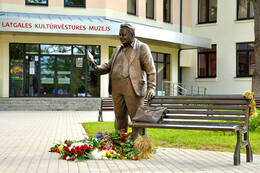Rēzeknes bombardavimas 1944 m
1944 m. Velykas įvyko Rezeknės bombardavimas, dėl to buvo sugriauta didelė dalis miesto pastatų, žuvo dešimtys civilių, o dar keli tūkstančiai liko be pastogės. Žmonės, kurie savo kailiu patyrė šiuos įvykius ir gali apie juos papasakoti, tuo metu buvo tik vaikai. Vienas iš jų yra ir šios istorijos autorius.
Tai buvo apie Velykas. Gyvenome Rėzeknėje, prie ežero. Rusijos lėktuvai ir bombonešiai skrido gana aukštai ir numetė lapelius, kad miestas bus subombarduotas ir gyventojai turėtų evakuotis. Kita vertus, vokiečių naikintuvai negalėjo skristi aukščiau ir šaudyti į tuos bombonešius. Tą pirmą naktį nebuvo bombarduojama, o paskui išvažiavome į kaimą link Maltos pabėgti. Tačiau bombardavimo nebuvo ir mes grįžome atgal. Kitą dieną vėl tas pats pasikartojo su lapeliais, bet jau netikėjome, neišėjome ir likome. Kitą dieną vėl mėtosi lapeliai, ten šaudo naikintuvai, o mes vėl netikėjome ir likome. Mama buvo kažkur išvykusi, namuose buvome tik tėvas ir mes, vaikai. Tėvas visą laiką sėdėjo ir klausėsi radijo. Pirmosios bombos sprogo naktį toli nuo mūsų, tada sprogo ežere, kur taip pat žuvo žmonės, tada viena bomba sprogo viename mūsų namo gale ir sunaikino pusę pastato. Aišku, tėvas bėgo pažiūrėti kas darosi su vaikais, bet jie visi miegojo, aš buvau vyriausia, bet buvo dar 2 seserys ir brolis, kuris buvo jauniausias, gimęs tik 1941 m., labai mažas. Visi pabėgome pro langą, nes durys buvo užrakintos ir išlipti negalėjome, tada tėvui padėjo kaimynai mus visus išnešti pro langus, o kieme buvo rūsys, kuriame prisiglaudėme. Daugelis tų raketų jau buvo paleistos ir iš mūsų kiemo matėme niokojimus, visas miestas buvo labai stipriai subombarduotas. Po to nebegrįžome į savo namus ir nebegyvenome. Po kiek laiko nuėjome pažiūrėti, ir viskas ten buvo visiškai pasikeitę. Iš pradžių po bombardavimo labai arti persikraustėme pas tolimus giminaičius, kurie buvo atlaisvinę pusę namo, nes dukra su vyru pabėgo į Ameriką. Po to įvykio tėvas su kitais vyrais jau ruošė sau bunkerį miške, jei kas vėl atvažiuos, gali ten pasislėpti. Vėliau, kai vokiečiai traukėsi, buvo atvejis, kai pas mus atėjo vienas kareivis, rankose turėjo rankinę granatą ir reikalavo duoti valgyti, mus apgyvendinusi šeimininkė davė vištų, kiaušinių ir kitų gėrybių. Paskui po to atėjo rusai ir apsigyveno mūsų kieme, o kadangi ten buvo daug moterų, mus visus vaikus vaišino šokoladu. Bet ir jie truko neilgai.
Susijusi laiko juosta
Susijusios vietos
IL-28 orlaivio skulptūra
Įsikūręs Skultės kaime, Marupės savivaldybėje, netoli Rygos tarptautinio oro uosto.
Skultė buvo vienas iš pavyzdinių kaimų, sukurtų sovietų kariškiams. Jame buvo dislokuotas aviacijos dalinys, kuris 1941 m. bombardavo Berlyną ir kitus miestus, taip pat dalyvavo Baltijos šalių okupacijoje. 1978 m. jame buvo įrengtas aplinkosaugos objektas – lėktuvas IL-28, skirtas pagerbti sovietų armijos pilotų nuopelnus Antrajame pasauliniame kare.
Po karo Sovietų Sąjunga tęsė aktyvią ginkluotės politiką. IL-28 buvo pirmasis, plačiausiai gaminamas sovietinis reaktyvinis bombonešis. Pirmoji serijinė atominė bomba RDS-4 („Tatjana“) buvo pagaminta iš to paties modelio 1953 m., siekiant patikrinti armijos gebėjimą pradėti ataką po branduolinio sprogimo. Lėktuvas turėjo įvairių modifikacijų. Bandymų metu jis pasiekė 906 km/h greitį, gabeno kelias tonas krovinio ir atliko 2445 km skrydį. Jį pilotavo 3 žmonių įgula.
Lėktuvas yra ne tik karinio paveldo liudininkas, bet ir ideologijos simbolis. 2010 m., minint Sovietų armijos pergalę prieš Vokietiją, lėktuvas buvo restauruotas. Taip pat buvo keletas nesėkmingų bandymų jį išardyti kaip objektą, šlovinantį Latvijos okupacinį režimą. Tai pavyko 2022 m., kai lėktuvas buvo perkeltas.
Šiuo metu orlaivį galima apžiūrėti netoliese esančiame Rygos aviacijos muziejuje Skultėje, taip pat susidaryti vaizdą apie sovietinės armijos kariškiams pastatytą kaimelį.
Latvijos okupacijos muziejus
Muziejuje eksponuojama Latvijos istorija nuo 1940 iki 1991 m., nacistinės Vokietijos ir Sovietų Sąjungos okupacijos laikotarpiu. „Ateities namai“ – tai žinomo Amerikos latvių architekto Gunāro Birkertaus suprojektuoto Okupacijos muziejaus rekonstrukcijos ir išplėtimo projektas, taip pat nauja muziejaus ekspozicija. Ekspoziciją „Čekos istorija Latvijoje“ sukūrė Okupacijos muziejus, ji yra buvusiame SSRS Valstybės saugumo komiteto (KGB) pastate „Kampiniame name“. Latvijos okupacijos muziejus buvo įkurtas 1993 m. Jis pasakoja ilgai slėptą Latvijos valstybės, tautos ir žemės likimo istoriją dviejų užsienio totalitarinių valstybių okupacijos laikotarpiu nuo 1940 iki 1991 m. 2020 m. pabaigoje muziejuje buvo daugiau nei 70 000 įvairių istorinių eksponatų (dokumentų, nuotraukų, rašytinių, žodinių ir daiktinių įrodymų, daiktų ir atminimo dovanų). Muziejaus specialistai įrašė daugiau nei 2400 vaizdo įrašų, todėl tai viena didžiausių okupacijos kolekcijų Europoje. Latvijoje, Lietuvoje ir Estijoje klostęsi įvykiai aiškiai parodo, ką tautoms teko ištverti valdant dviem totalitariniams režimams.
Latgalos kultūros istorijos muziejus
Latgalos kultūros istorijos muziejuje Rėzeknėje veikia trys nuolatinės ekspozicijos. Viena jų – „Rėzeknė laikmečių san dūroje“ – pasakoja apie daugiau kaip septynis šimtmečius besitęsiančią miesto istoriją. Didelė ekspozicijos dalis skirta XX a. įvykiams, karams ir besikeitusiems laikotarpiams: Pir masis pasaulinis karas, Nepriklausomybės karas, Antrasis pasaulinis karas, 1944 m. sovietų bombonešių antskrydis, taip pat karo belaisvių stovykla „Stalag 347“. Ekspozicijoje yra fotografijų stendas, skirtas Rėzeknės kareivių likimams karo metais. Latvijos nepriklausomybės laikais Rėzeknėje buvo dislokuo tas Latvijos kariuomenės 9-asis Rėzeknės pėstininkų pulkas, kuris tapo neatsiejama miesto visuomeninio gyvenimo ir sporto renginių dalimi – ypač per lapkričio 11 d. (Laisvės gynėjų dienos) ir lapkričio 18 d. (Latvijos nepriklausomybės dienos) minėjimus.







